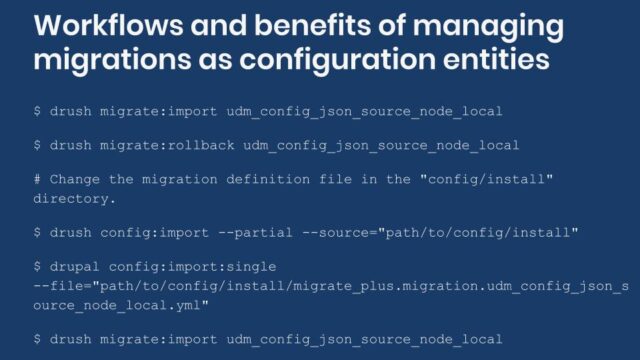Workflows and benefits of managing Drupal migrations as configuration entities
In the last blog post we were introduced to managing migration as configuration entities using Migrate Plus. Today, we will present some benefits and potential drawbacks of this approach. We will also show a recommended workflow for working with migration as configuration. Let’s get started.

What is the benefit of managing migration as configurations?
At first sight, there does not seem to be a big difference between defining migrations as code or configuration. You can certainly do a lot without using Migrate Plus’ configuration entities. The series so far contains many examples of managing migrations as code. So, what are the benefits of adopting s configuration entities?
The configuration management system is one of the major features that was introduced in Drupal 8. It provides the ability to export all your site’s configuration to files. These files can be added to version control and deployed to different environments. The system has evolved a lot in the last few years and many workflows and best practices have been established to manage configuration. On top of Drupal core’s incremental improvements, a big ecosystem has sprung in terms of contributed modules. When you manage migrations via configuration, you can leverage those tools and workflows.
Here are a few use cases of what is possible:
- When migrations are managed in code, you need file system access to make any changes. Using configuration entities allows site administrators to customize or change the migration via the user interface. This is not about rewriting all the migrations. That should happen during development and never on production environments. But it is possible to tweak certain options. For example, administrators could change the location to the file that is going to be migrated, be it a local file or on remote server.
- When writing migrations, it is very likely that you will work on a subset of the data that will eventually be used to get content into the production environment. Having migrations as configuration allow you to override part of the migration definition per environment. You could use the Configuration Split module to configure different source files or paths per environment. For example, you could link to a small sample of the data in development, a larger sample in staging, and the complete dataset in production.
- It would be possible to provide extra configuration options via the user interface. In the article about adding HTTP authentication to fetch remote JSON and XML files, the credentials were hardcoded in the migration definition file. That is less than ideal and exposes sensitive information. An alternative would be to provide a configuration form in the administration interface for the credentials to be added. Then, the submitted values could be injected into the configuration for the migration. Again, you could make use of contrib modules like Configuration Split to make sure those credentials are never exported with the rest of your site’s configuration.
- You could provide a user interface to upload migration source files. In fact, the Migrate source UI module does exactly this. It exposes an administration interface where you have a file field to upload a CSV file. In the same interface, you get a list of supported migrations in the system. This allows a site administrator to manually upload a file to run the migration against. Note: The module is supposed to work with JSON and XML migrations. It did not work during my tests. I opened this issue to follow up on this.
These are some examples, but many more possibilities are available. The point is that you have the whole configuration management ecosystem at your disposal. Do you have another example? Please share it in the comments.
Are there any drawbacks?
Managing configuration as configuration adds an extra layer of abstraction in the migration process. This adds a bit of complexity. For example:
- Now you have to keep the `uuid` and `id` keys in sync. This might not seem like a big issue, but it is something to pay attention to.
- When you work with migrations groups (explained in the next article), your migration definition could live in more file.
- The configuration management system has its own restrictions and workflows that you need to follow, particularly for updates.
- You need to be extra careful with your YAML syntax, specially if syncing configuration via the user interface. It is possible to import invalid configuration without getting an error. It is until the migration fails that you realize something is wrong.
Using configuration entities to define migrations certainly offers lots of benefits. But it requires being extra careful managing them.
Workflow for managing migrations as configuration entities
The configuration synchronization system has specific workflows to make changes to configuration entities. This imposes some restrictions in the way you make updates to the migration definitions. Explaining how to manage configuration could use another 31 days blog post series. 😉 For now, only a general overview will be presented. The general approach is similar to managing configuration as code. The main difference is what needs to be done for changes to the migration files to take effect.
You could use the “Configuration synchronization” administration interface at `/admin/config/development/configuration`. In it you have the option to export or import a “full archive” containing all your site’s settings or a “single item” like a specific migration. This is one way to manage migrations as configuration entities which let’s you find their UUIDs if not set initially. This approach can be followed by site administrators without requiring file system access. Nevertheless, it is less than ideal and error prone. This is not the recommended way to manage migration configuration entities.
Another option is to use Drush or Drupal Console to synchronize your site’s configuration via the command line. Similarly to the user interface approach, you can export and import your full site configuration or only single elements. The recommendation is to do partial configuration imports so that only the migrations you are actively working on are updated.
Ideally, your site’s architecture is completed before the migration starts. In practice, you often work on the migration while other parts of the sites are being built. If you were to export and import the entire site’s configuration as you work on the migrations, you might inadvertently override unrelated pieces of configurations. For instance, this can lead to missing content types, changed field settings, and lots of frustration. That is why doing partial or single configuration imports is recommended. The following code snippet shows a basic Drupal workflow for managing migrations as configuration:
# 1) Run the migration. $ drush migrate:import udm_config_json_source_node_local # 2) Rollback migration because the expected results were not obtained. $ drush migrate:rollback udm_config_json_source_node_local # 3) Change the migration definition file in the "config/install" directory. # 4a) Sync configuration by folder using Drush. $ drush config:import --partial --source="modules/custom/ud_migrations/ud_migrations_config_json_source/config/install" # 4b) Sync configuration by file using Drupal Console. $ drupal config:import:single --file="modules/custom/ud_migrations/ud_migrations_config_json_source/config/install/migrate_plus.migration.udm_config_json_source_node_local.yml" # 5) Run the migration again. $ drush migrate:import udm_config_json_source_node_local
Note the use of the `–partial` and `–source` flags in the migration import command. Also note that the path is relative to the current working directory from where the command is being issued. In this snippet, the value of the source flag is the directory holding your migrations. Be mindful if there are other non-migration related configurations in the same folder. If you need to be more granular, Drupal Console offers a command to import individual configuration files as shown in the previous snippet.
Note: Uninstalling and installing the module again will also apply any changes to your configuration. This might produce errors if the migration configuration entities are not removed automatically when the module is uninstalled. Read this article for details on how to do that.
What did you learn in today’s blog post? Did the know benefits and trade-offs of managing migrations as configuration? Did you know what to do for changes in migration configuration entities to take effect? Share your answers in the comments. Also, I would be grateful if you shared this blog post with others.
